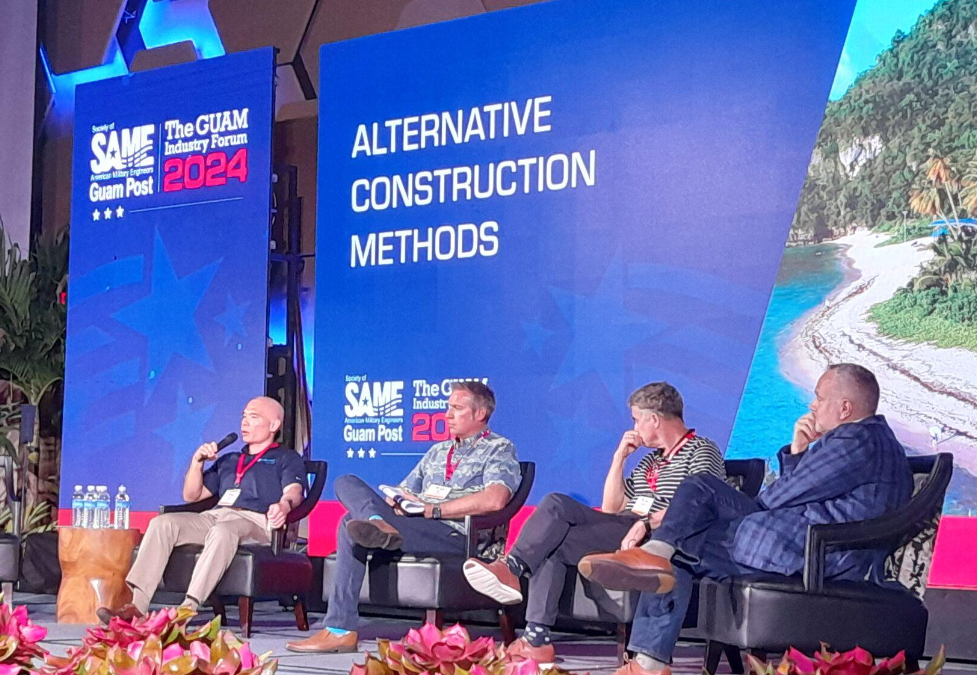
Evan Mizue, left, design director at Naval Facilities Engineering Systems Command Pacific, answers questions during a panel discussion at the SAME Guam Industry Forum on Friday, Nov. 15, 2024, at the Dusit Thani Guam Resort in Tumon.
HAGÅTÑA (The Guam Daily Post) — The infusion of billions of dollars in construction projects into Guam and the Western Pacific is driving a search for alternative methods of construction, especially as tensions rise in the region and over $20 billion in investments is expected over the next decade.
“Our Naval Facilities Engineering Systems Command commander’s push to do this just came out in October. We are launching upon it with speed right now,” said Evan Mizue, design director at NAVFAC Pacific. Mizue spoke to The Guam Daily Post on Friday. He was one of the panelists on the alternative construction methods panel discussion at the 2024 Guam Industry Forum organized by the Guam Post of the Society of American Military Engineers.
“This is the first time we actually engaged industry on a broad scale to introduce the Navy’s new direction to innovate and explore alternative construction methods,” said Mizue.
Mizue said, “The Navy is more open to using innovative construction techniques that we have not utilized before in Guam.” He added, “Most of our construction in Guam tends to be precast concrete or reinforced concrete. We think there are other solutions out there that can meet our requirements, that can perhaps come at a much more affordable price.”
One popular alternative construction method is prefabricated modular construction. According to Mizue, other than some isolated cases of precast construction, he doesn’t “think anything is working right now as a truly innovative prefabricated, modular, pre-engineered-type construction. We are just right now starting to open the aperture to that.”
The Post also spoke with Aaron Isle, the federal senior project executive with the California-based Granite Construction company. Isle was the moderator of the alternative construction methods panel at the forum and spoke to the advantages of prefab modular construction.
“It cuts down on costs, you have a higher quality of production…and then you drastically reduce the schedule,” said Isle.
This type of construction “helps ease the labor burden on Guam. That has a ripple effect, domino effect in so many areas of labor, of housing and just the impacts to the community,” Isle said.
When asked why there haven’t been many, if any, alternative construction methods, such as prefab modular techniques, applied within the industry in Guam, Mizue commented that “definitely an obstacle or challenge is the proprietary nature of the new technology and prefabrication operations.”
Another factor, said Mizue, is “the construction industry tends to be conservative in taking risks on new innovative technologies, and I think for NAVFAC, a lot of our requirements…are built upon conventional approaches, and we are going to try and change that.”
Isle spoke to these challenges and mentioned that the ability to change regulations “resides at (Washington, D.C.), so a lot of it is just motivating people to look at innovation and open the focus to start looking at ways that we can do things better, faster, smarter.”
Isle also added that “focus is paramount on posturing a deterrence in the Pacific, and that’s allowing people a little more latitude…and start to look at ways that we can accelerate innovation and accelerate accepting that innovation into the construction practices on Guam.”
“Cutting-edge technology is being tested and refined as we speak, and NAVFAC is taking a stance to lean forward on this and try to get ahead of it,” said Isle.
Isle mentioned that research and development at the Department of Defense is “primarily focused on things other than construction, so a lot of the innovation comes from the private sector and filters into the DOD sector.” Isle iterated that DOD is looking to try to get ahead of that and asking how it can “move at the speed of industry.”
Another innovative high-tech solution to cutting costs in the industry is additive manufacturing in construction, or 3D construction printing. Both Mizue and Isle said they have not seen this type of innovation applied yet in Guam. However, Isle said the panel at the forum “was the catalyst to start the flow of ideas.”
“Historically,…standard construction has been acceptable. It has worked. It has met the pace and scale of delivery, and right now, we’re in an unprecedented need for a scale of delivery that has never been seen since World War II. So, people like NAVFAC now are saying,…‘We’re seeing a buildup like never before, and we need to be on the forefront of innovation.’ ”











